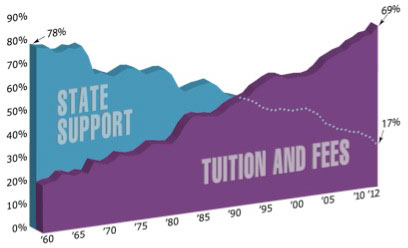This is part of an ongoing series of printable pamphlets designed to explain how money flows through public research universities in general and the University of Michigan in particular. The pamphlets are intended to clarify arguments and push back against pervasive and seemingly “common sense” narratives about the crisis of public higher education that impede, rather than advance, meaningful political action. We hope tactics and strategies will emerge from these counter-narratives—after all, we can’t fight what we don’t understand. Download the printable version of this pamphlet here and see the Resources page for the entire series.
Why has tuition grown so much and so fast at the University of Michigan? According to the administration, it has to do with “the long-term decline in state funding.”[1] We’re going to show you why this story is at best incomplete and at worst manipulative. It’s true that since the 1970s politicians around the country have cut budgets for many social services, including public higher education. Using the chart on the following page, the administration argues that state funding made up 78% of U-M’s general fund budget in the 1960s, but by 2012 this number had fallen to 17%. The chart suggests that tuition has increased to replace it, and the two streams are about equal.
So what’s missing from the administration’s story?
First, it’s important to recognize that the university’s budget is far more complex than the chart suggests. There’s not just two streams of revenue into the university. The general fund only represents a small piece of the university’s operating activities. As the pie chart on the next page indicates, other significant revenue sources include federal research grants (about $1 billion), distributions from the endowment (about $400 million), and gifts (about $150 million).[2] Why is this important? It shows that, even when we take the state’s budget cuts into account, overall revenue at U-M is actually increasing significantly. Over the last decade, for example, total revenue for operating activities (excluding the health system) has jumped from about $2.2 billion to $3.4 billion per year.[3] During that same period, state funding fell by just $41 million, while the revenue generated by student tuition increased by an astronomical $466 million. Even if state funding had remained constant, there would still be a lot more money floating around in the system, and students are more than making up for the difference.
